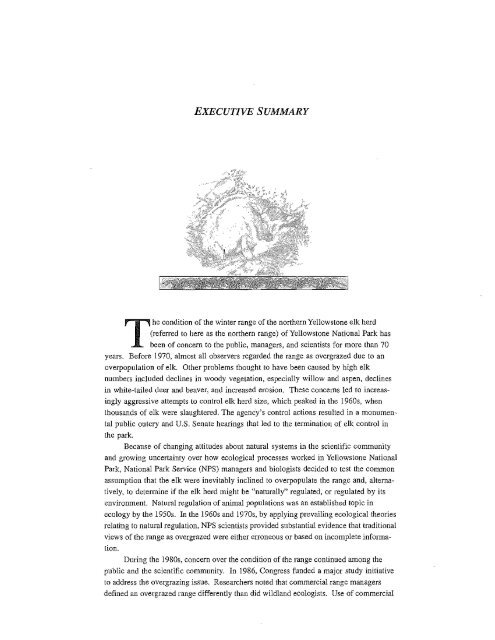Yellowstone's Northern Range - Greater Yellowstone Science ...
Yellowstone's Northern Range - Greater Yellowstone Science ...
Yellowstone's Northern Range - Greater Yellowstone Science ...
You also want an ePaper? Increase the reach of your titles
YUMPU automatically turns print PDFs into web optimized ePapers that Google loves.
EXECUTIVE SUMMARY<br />
The condition of the winter range of the northern <strong>Yellowstone</strong> elk herd<br />
(refen-ed to here as the northern range) of <strong>Yellowstone</strong> National Park has<br />
been of concern to the public, managers, and scientists for more than 70<br />
years. Before 1970, almost all observers regarded the range as overgrazed due to an<br />
overpopulation of elk. Other problems thought to have been caused by high elk<br />
numbers included declines in woody vegetation, especially willow and aspen, declines<br />
in white-tailed deer and beaver, and increased erosion. These concerns led to increasingly<br />
aggressive attempts to control elk herd size, which peaked in the 1960s, when<br />
thousands of elk were slaughtered. The agency's control actions resulted in a monumental<br />
public outcry and U.S. Senate hearings that led to the termination of elk control in<br />
the park.<br />
Because of changing attitudes about natural systems in the scientific community<br />
and growing uncertainty over how ecological processes worked in <strong>Yellowstone</strong> National<br />
Park, National Park Service (NPS) managers and biologists decided to test the common<br />
assumption that the elk were inevitably inclined to overpopulate the range and, alternatively,<br />
to determine if the elk herd might be "naturally" regulated, or regulated by its<br />
environment. Natural regulation of animal populations was an established topic in<br />
ecology by the 1950s. In the 1960s and 1970s, by applying prevailing ecological theories<br />
relating to natural regulation, NPS scientists provided substantial evidence that traditional<br />
views of the range as overgrazed were either erroneous or based on incomplete information.<br />
During the 1980s, concern over the condition of the range continued among the<br />
public and the scientific community. In 1986, Congress funded a major study initiative<br />
to address the overgrazing issue. Researchers noted that commercial range managers<br />
defined an overgrazed range differently than did wildland ecologists. Use of commercial















